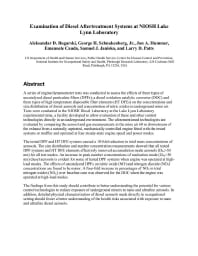Mining Publication: Examination of Diesel Aftertreatment Systems at NIOSH Lake Lynn Laboratory
Original creation date: October 2007
Authors: AD Bugarski, GH Schnakenberg, JA Hummer, E Cauda, SJ Janisko, LD Patts
NIOSHTIC2 Number: 20033036
In: MDEC 2007. Proceedings of the Mining Diesel Emissions Council (MDEC) Conference (Richmond Hill, Ontario, Canada, October 1-5, 2007); : 19 pp.
A series of engine/dynamometer tests was conducted to assess the effects of three types of uncatalyzed diesel particulate filters (DPFs), a diesel oxidation catalytic converter (DOC) and three types of high temperature disposable filter elements (HT DFEs) on the concentrations and size distribution of diesel aerosols and concentration of nitric oxides in underground mine air. Tests were conducted in the NIOSH Diesel Laboratory at the Lake Lynn Laboratory experimental mine, a facility developed to allow evaluation of these and other control technologies directly in an underground environment. The aforementioned technologies are evaluated by comparing the aerosol and gas measurements in the mine air 60 m downstream of the exhaust from a naturally aspirated, mechanically controlled engine fitted with the tested systems or muffler and operated at four steady-state engine speed and power modes. The tested DPF and HT DFE systems caused a 10-fold reduction in total mass concentrations of aerosols. The size distribution and number concentration measurements showed that all tested DPF systems and HT DFE elements effectively removed accumulation mode aerosols (D50>30 nm) for all test modes. An increase in peak number concentrations of nucleation mode (D50>30 nm) diesel aerosols is evident for some of tested DPF systems when engine was operated at high-load modes. The effects of uncatalyzed DPFs on nitric oxide (NO) and nitrogen dioxide (NO2) concentrations are found to be minor. A four-fold increase in percentages of NO2 in total nitrogen oxides (NOx) over baseline case was observed for the DOC when the engine was operated at high-load modes. The findings from this study should contribute to better understanding the potential for various control technologies to reduce exposure of underground miners to nano and ultrafine aerosols. In addition, detailed physical characterization of diesel aerosols made directly in occupational setting should foster a better understanding of the health risks associated with exposure to nano and ultrafine diesel aerosols.

NIOSHTIC2 Number: 20033036
In: MDEC 2007. Proceedings of the Mining Diesel Emissions Council (MDEC) Conference (Richmond Hill, Ontario, Canada, October 1-5, 2007); : 19 pp.